Marine wilderness
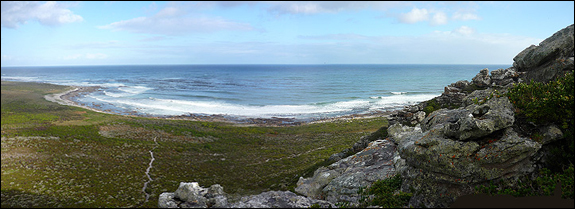 Path from Gifkommetjie to Platboom - Cape of Good Hope Reserve
Path from Gifkommetjie to Platboom - Cape of Good Hope Reserve
|
Following national service I worked as a lifeguard at Kleinemonde in the Eastern Cape and then From 1989 to 1990 I worked as a wilderness guide on the Orange River. As guides it was our job to take groups on four day rafting trips down the river, through the Richtersveld along the South African and Namibian border. Doing this work I learned about the effects that experiemces in the wilderness can have on people. It was part of our job as guides to use the experiences in nature to encourage teamwork, self respect etc. Basically to bring out the best in people and get people having a good time.
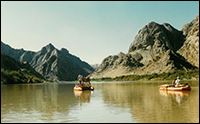
|
|
From 1990 to 2001 while working on the Durban Beachfront as lifeguards we worked with law enforcement to try to maintain order along the beachfront. This was a period of political turmoil and there was ongoing violence and crime as well as extreme social problems. After working as a wilderness guide I was conscious of the importance of keeping connected to nature which is part of the surfing lifestyle.
In 1999 I worked for Tripper (who was importing sea Kayaks) to set up sea Kayak trips. I was also doing surf-ski repairs for Tripper and through this I met Wilderness Leadership School guides, Ian Read and Keith Roberts, who were keen ski paddlers. People linked to WLS took a very serious interest in matters involving wilderness. As well as a variety of outstanding trails WLS do community outings which include carefully facilitated programs for vulnerable youth, treatment of addiction and psychological treatment programs using wilderness therapy as a tool. I liked the WLS approach to conservation and felt it was appropriate to link the work I was doing with marine conservation and surfers to the work of the conservationists in the wilderness group.
I did a sea kayaking course with Keith and Ian at Saldanha and they helped me with preparing my kayak trips in the Durban area. The basic idea was to deal with the sea as a wilderness area and do simple outings into natural areas along the coast to encourage an appreciation of nature.
It seemed to me that in the city the sea is an accessible wilderness area where simple outings into nature could be developed with a view to developing more involved trails as things progressed.
Friends of WLS suggested I do a painting of Dr Player to commemorate his 80th birthday in 2007. Through this I was able to meet Dr Player. This was an inspiring experience and he encouraged me to continue developing my conservation work dealing with the sea as a wilderness area. |
Orange River
|

|
|
Durban Beachfront 1 Jan 1999
|
In 2008 The Magqubu Ntombela Foundation bought the painting of Dr Ian Player for R 22 000. Half of this was donated to WLS for the training of a Wilderness Guide. The painting is displayed at the entrance to the Ian Player, Magqubu Ntombela Library in Hillcrest.
In 2008 I move to Cape Town where I worked for the Save Our seas foundation and (KELP) Kelp Environmental Learning Project as an environmental educator.
At the SOS Shark centre at Kalk Bay I was involved with helping with lessons, presentations and coastal litter clean ups etc as I had experience with water safety. I also developed rock pool lessons as part of our education programme. We progressed to develop our own programme dealing with sharks and marine conservation. We visited various education centres in Cape Town to learn about environmental education and then put together a programme that was fresh and different from what other centres were doing. Our shark lesson programme was made up of a shark lesson in the class room, a rock pool outing at Dalebrook Beach and a movie about sharks.
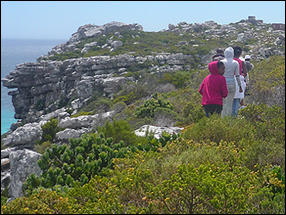 |
|
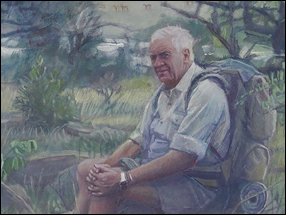 |
Cape Point Outings |
|
Dr Ian Player - 2007 |
Groups were encouraged to be gentle with the creatures. Children were encouraged as future leaders to find solutions to conservation problems. We worked with thousands of people from various backgrounds from 2008 to 2010 but largely school groups from disadvantaged backgrounds. We worked with the City of Cape Town Youth Environment School to bring underprivileged kids and others on outings and we reached many people through outreach programmes and by participating in various events. We did lessons at the Shark Centre as well as presentations at functions, outreach programmes and litter clean-ups etc.
At the same time I was also developing an education programme for KELP which tied in with the Shark Centre programme. Groups doing the KELP lesson were shown a movie about life in the kelp forests, they then did a beach outing to learn about life in the rock pools and the life cycles involving the kelp forests as well as the kelp once it is washed ashore. After this they went on to paint their own kelp vuvuzela made from kelp dried on the shore. The vuvuzela painting lesson added a fun, art, creative dimension to the programme.
Developing the Shark Centre rock pool lessons and KELP lessons was an opportunity to develop small scale marine wilderness outings as begun with the WLS guides and the Wilderness Action Group in Durban.
The outdoor lessons were very successful. After many years on Durban Beachfront I found the experience I had had with inner city problems was also helping me interact productively with the many visitors from disadvantaged backgrounds. Our approach as educators was to be realistic about the problems of SA and encourage people to find practical solutions.
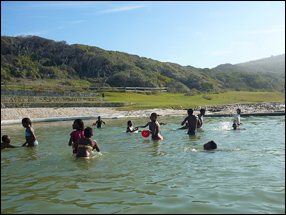 |
|
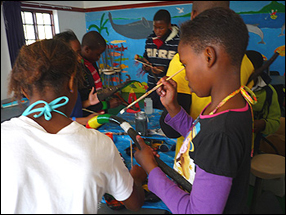 |
Tidal Pool - Cape Point |
|
Painting vuvuzelas - Cape Point |
In CT I did a presentation about marine wilderness to Dr Ian MacCallum, and the Pride of Table Mountain group, the CT wing of the Wilderness Leadership School. Following this the Pride group visited the Shark Centre to do our education programme and learn about marine issues and I attended meetings at their school as well as an outing on Table Mountain.
With other members of the CTWLS I developed the rock pool outings further combining this with a short marine wilderness trail and a kelp painting exercise in the Cape of Good Hope Reserve. I was able to link with SAN Parks education department to set up simple marine wilderness trails in the reserve using SANParks education fascilities with a view to expanding this in time into more remote areas. At a meeting at CTWLS we were told that we would be welcome to take our work, developing further trails forward independently under the banner of the WLS. Since then I have continued to develop my marine wilderness education programme independently.
I did a marine wilderness presentation and kelp painting exercise at the Marine Coastal Educators Network conference in 2010
In 2010 leading up to the world cup I was filmed by 50/50 environmental program at the Shark Centre doing the kelp vuvuzela lesson with the Ocean View environmental club.
Through my involvement with SOS and KELP I was able to link with surfing and lifesaving groups in Cape Town and begin developing a surfing environmental programme through Save Our Seas. During the time of the World Cup (June 2010) I worked with Glenn Bee and the Kommetjie Christian Church to arrange a surf school in memory of Pierre Du Plessis, Glen's big wave surfing tow-in partner who died unexpectedly. I did the rock pool and kelp painting lessons and helped with surfing lessons.
I also worked with TimConiber from Waves for Change combining marine wilderness environmental lessons and kelp painting with surf lessons for young people from Masipumelele.
In 2011 following the world cup I left the Shark Centre and KELP to develop my conservation work independently.
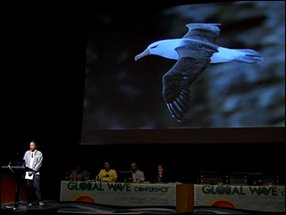 |
|
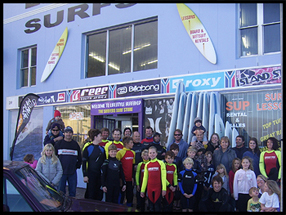 |
Global Wave Conference 2011 |
|
Surf school in memory of Pierre Du Plessis |
In Kommetjie I met Dr Tony Butt, big wave surfer, oceanographer and board member of UK surf conservation group, Surfers Against Sewage. Tony was arranging a conference in Europe with Surfrider Foundation to discuss international conservation issues in the surfing world. He invited me to speak at the Global Wave Conference in Oct 2011. My subject was connecting to nature through surfing.
Following this, since 2012, I have been working for the RNLI in Cornwall UK which has allowed me to tie in with international groups.
I have done presentations at the Cornwall College, Newquay and explored possibilities of working with Plymouth University students to do conservation projects in SA linked to Rhodes University and the Amakhala Foundation. I have been interested in tying in with conservationists in SA dealing with the mainstream conservation issues in SA to create opportunities for international students and volunteers.
In 2015 I spoke at the Global Wave Conference 2015 in Cornwall. In 2017 I was contacted by Grant Cleghorn from Gone Outdoors shop in Cape Town. He is selling Patagonia products in SA and supporting SA conservationists. I did a KELP lesson with the 9Miles Project, a project supportrd by Gone Outdoors. I had begun raising money for a marine wilderness conservation through the sale of my art and prints.
In
2018 I did a presentation and displayed my art at Gone Outdoors. I then did a presentation and displayed my art at the Patagonia shop in Manchester (UK)
Following this I arranged a charity night in St Merryn, Cornwall and Patagonia, Manchester as well as making a generous donation provided prizes for the raffle.
 |
|
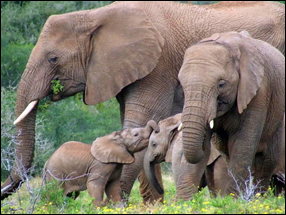 |
Waimea Bay - Hawaii |
|
Amakhala Game Reserve - Eastern Cape |
At this stage £1 300 has been raised through the sale of prints, donations and the charity night. I have also raised
£20 000 independently and the total is intended for conservation work in South africa.
My plan is to continue raising money and awareness for marine wilderness conservation in South Africa through presentations and the sales of prints and paintings.
The objectives are:
1 To raise money to buy land on the coast to be managed as conservation areas and used for education and conservation work.
2 Develop projects to help marine wilderness conservation.
3 Continue developing an education programme that informs people about the problems conservationists in South Africa are facing up to and through outings into the outdoors encourages an awareness and appreciation of wild areas and wildlife.
If we do not manage to meet our objectives the funds raised will be given to an organisation or organisations doing similar work.
I am interested in tying in with people in Hawaii through which to sell paintings and prints and take conservation work further.
You can see more info about the conservation work etc that I have been doing by following the links on the side. |